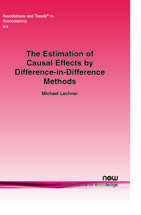The Estimation of Causal Effects by Difference-in-Difference Methods
By Michael Lechner, Professor of Econometrics, Swiss Institute for Empirical Economic Research (SEW), University of St. Gallen,, Switzerland, Michael.Lechner@unisg.ch
Abstract
This survey gives a brief overview of the literature on the difference-in-difference (DiD) estimation strategy and discusses major issues using a treatment effects perspective. In this sense, this survey gives a somewhat different view on DiD than the standard textbook discussion of the DiD model, but it will not be as complete as the latter. It contains some extensions of the literature, for example, a discussion of, and suggestions for nonlinear DiD estimators as well as DiD estimators based on propensity-score type matching methods.
The Estimation of Causal Effects by Difference-in-Difference Methods
The Estimation of Causal Effects by Difference-in-Difference Methods presents a brief overview of the literature on the difference-in-difference estimation strategy and discusses major issues mainly using a treatment effect perspective that allows more general considerations than the classical regression formulation that still dominates the applied work. In this sense, this monograph offers a somewhat different perspective than the standard text book discussion of the difference-in-difference design. The Estimation of Causal Effects by Difference-in-Difference Methods focuses on the case of only two differences although the basic ideas of difference-in-difference (DiD) estimation could be extended to more than two dimensions to create difference-in-difference-in-difference-in-… estimators. However, the basic ideas of the approach of taking multiple differences are already apparent with two dimensions. Thus, the authors refrain from addressing these higher dimensions to keep the discussion as focused as possible.
The Estimation of Causal Effects by Difference-in-Difference Methods starts by providing a historical perspective and discusses some interesting applications. The main part of this survey discusses identification issues at length. The next section concerns DiD specific issues related to estimation, including a discussion of propensity score matching estimation of DiD models. The monograph then discusses some specific issues related to inference and considers important practical extensions to the basic approach. Some short proofs are relegated to a technical appendix.
The Estimation of Causal Effects by Difference-in-Difference Methods should be of interest to all empirical economicsts and other social scientists using empirical methods.
